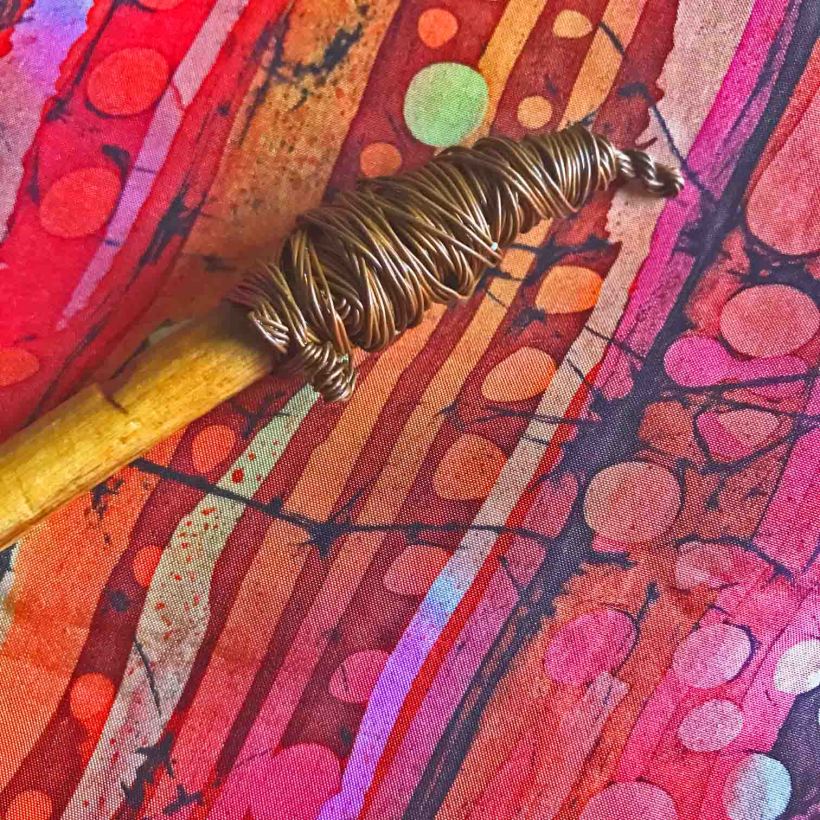
My textile treasure from The Gambia, the gift of a former student.
When unpacking after teaching at West Dean this week, I noticed one of my favourite tools hadn’t re-appeared from the boxes. I began to realise how precious the tool was, and kicked myself for being sufficiently stupid to take it out of the studio and risk losing it. The tool is no bigger than a long paintbrush, it’s clearly home-made and would look insignificant to anyone finding it but not ‘in the know’ about what it was. It could have been binned, or slipped beneath a workbench. It might never re-appear.
The tool, used for applying wax, was given to me nearly ten years ago by an inspiring and enterprising young student who left us with very special memories of her. She was on a scholarship studying batik world-wide and she stayed with us for a few days while I showed her how I worked. She later travelled to The Gambia, and sent me the tool on her return. It has a simply-shaped, graceful wooden handle around the tip of which is wound a casual-looking thick spiral of copper wire. The spiral forms into a tightly-twisted, spout-shaped ‘nib’.
The copper tool can be dipped into hot wax, and because copper is a good conductor of heat the entire wire quickly reaches equal temperature. The coils of the spiral hold a considerable cargo of hot wax, which flows down into the ‘nib’ allowing a controlled drawing to be made in hot wax. Experience has taught me not to start drawing until drip frequency is slow, or wax flows too fast and floods the fabric. The tool looks as though it shouldn’t work, but in fact it’s remarkably effective and one of my studio favourites.
Some time ago I tried to replicate the tool for students in my classes, using copper wire and a substantial twig, or an old paintbrush, for a handle. I have had surprising success with them and I’ve found, for instance, that a narrower gauge wire can form a finer nib. But none of my versions has the grace and integrity of the original, or carries its history. I instinctively choose the Gambia tool when working, even though my replicas work just as well.
The tool was created by people who own little and must labour extremely hard to produce their batik work: they have no electricity, gather wax from bee-hives, heat wax on a fire and carry all their water by hand. Only when I unpacked my boxes and contemplated the possible loss of my student’s gift did I acknowledge (for the first time) that the tool’s story was as important as its function.
Happily, I found it.
Link: This remarkable little book tells the story of Rushyan’s batik journey
Paths of Molten Wax: A Textile Odyssey

September 11, 2018 at 9:14 pm
What an amazing story…so happy you found it,Isabella. Love Eva
Sent from my iPad
>
September 11, 2018 at 9:15 pm
I’m so pleased you found it for I know well enough how one gets attached to different tools (and other artefacts, as you say, not necessarily expensive or ‘posh’), so much so they almost become a third hand, and in the process of course accrue great personal sentiment.
September 11, 2018 at 9:26 pm
Thanks, Eva. So am I. It would have been a great loss.
September 11, 2018 at 9:29 pm
Thanks, Richard. It’s also why we find some things so hard to throw away, I suppose. Objects attract memories and emotions and it can feel as though we are throwing those away with the thing itself. .
September 11, 2018 at 9:45 pm
Yes, that’s so true.
September 17, 2018 at 1:42 pm
Woot!
September 17, 2018 at 8:07 pm
So glad you found it.
It was lovely to meet you at the Devon Guild a few weeks ago.I am taking the little bag to India with me in a few weeks to hold my journal. Today I found in my bag the piece of paper I dip dyed and wonder if you could refresh my memory as to how to make the little Indigo God. (i think thats what it was called!)
September 17, 2018 at 9:05 pm
Hi Bethan,
How nice to hear from you. I’m away from home for a few days so it’s not easy to explain how to make the god (following Japanese tradition) without a sample. I’ll send some instructions when I get home. Where are you off to in India?
September 17, 2018 at 9:51 pm
Thank you. I’m off to Delhi, Jaipur and pushkar with my Daughter.